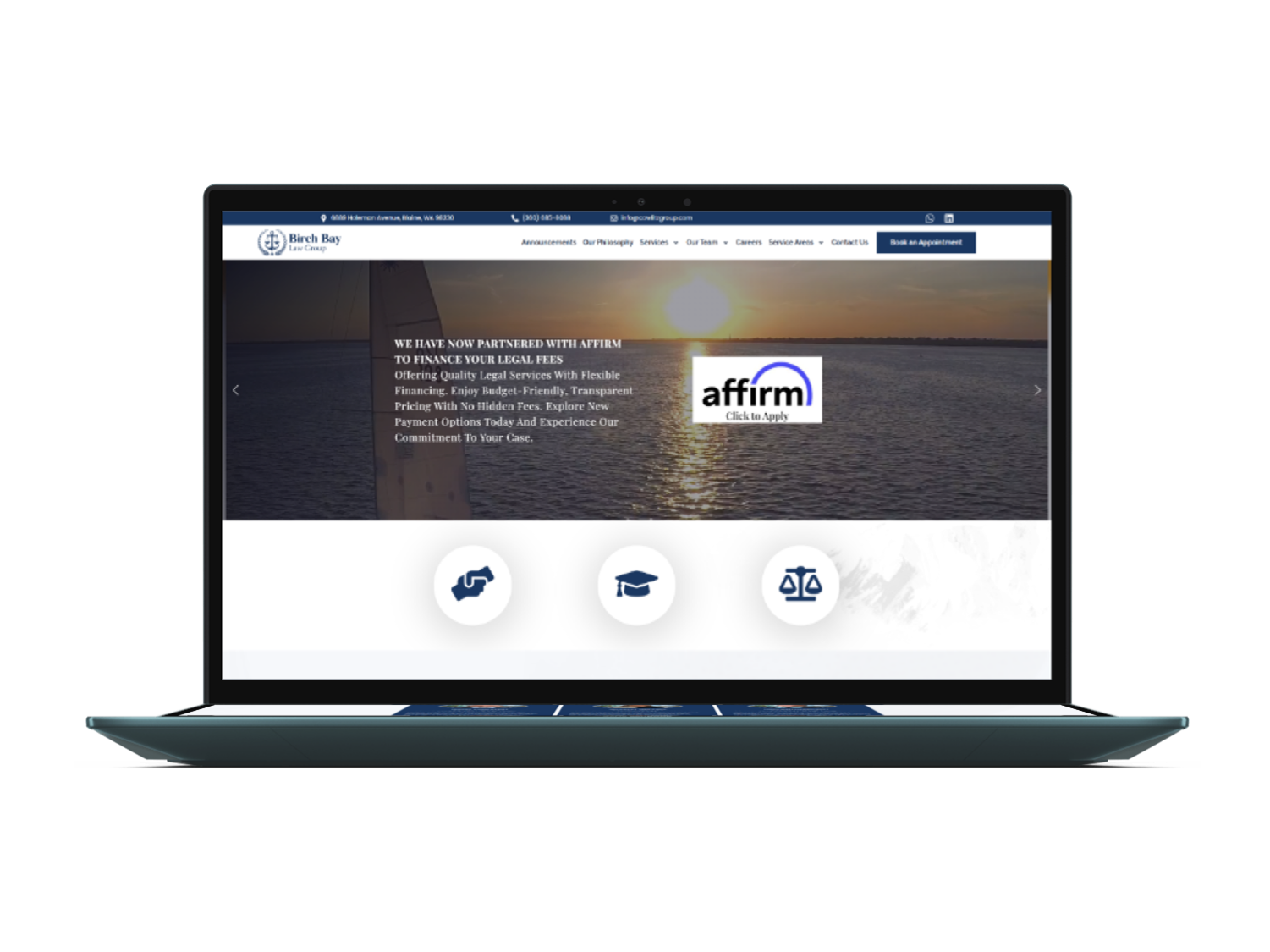
Birch Bay Law Group Website
Case Study
Birch Bay Law Group is a professional law firm providing comprehensive legal services to individuals and businesses in various sectors. The client’s main objective was to enhance their online presence with a website that effectively conveys trust, professionalism, and clarity, while also being user-friendly and optimized for mobile.

01
Project Objective
The primary goal of the website redesign was to create a modern, professional platform that would help Birch Bay Law Group build a stronger online reputation. The website needed to reflect the firm’s legal expertise while providing potential clients with clear, easy-to-navigate information about their services.
Specific objectives:
Develop a professional design that instills confidence and trust.
Make the website visually engaging while maintaining clarity.
Ensure the website is responsive, particularly for mobile users.
Make client interaction simple through clear calls to action (CTAs) and contact forms.
Research and Analysis
Before starting the design process, research was conducted into Birch Bay Law Group’s brand, its target audience, and its competitors. The firm’s primary audience consists of individuals and businesses in need of legal advice and services, often seeking clarity and professionalism in a highly competitive field.
Key insights from the analysis:
Target audience: Professionals and businesses seeking legal counsel.
Competitor analysis: Competitor websites were reviewed to identify design trends, best practices in the legal industry, and areas for improvement.
02
03
Design Solutions
Visual Design:
The website’s design was focused on achieving a balance between professionalism and accessibility. A clean, modern aesthetic was applied with a strong use of typography and an easy-to-navigate layout that conveys trustworthiness.
Color scheme: A conservative color palette of blue, white, and gray was used to represent professionalism and trust. Blue is often associated with confidence and stability, which aligns with the nature of a law firm.
Typography: The fonts were carefully chosen to be legible and professional, with a clean sans-serif font for headings and a serif font for body text to create a sense of reliability.
Service Presentation:
One of the main design challenges was to clearly highlight the firm’s legal services without overwhelming the user. A service section was created with easy-to-read headings, brief descriptions, and a clear layout to ensure that visitors could quickly find the information they were looking for.
Mobile Optimization:
The design was fully responsive, meaning the website adapts perfectly to different screen sizes, ensuring a smooth experience for mobile and tablet users. This was especially important, as more users access websites through mobile devices today than ever before.
Navigation was simplified for mobile users, ensuring that key information, such as contact details and services, was easily accessible on smaller screens.
Calls to Action (CTAs):
Prominent CTAs like “Request a Consultation” were strategically placed throughout the site to encourage potential clients to take the next step. These CTAs were designed to be clearly visible without being intrusive, ensuring that visitors could easily get in touch with the firm.
Development Process
The website was built using HTML5, CSS3, and JavaScript for smooth interaction and responsiveness. The CMS platform chosen was WordPress, which allowed the firm to easily update the site’s content without needing technical expertise.
Key elements of the development process included:
Responsive design implementation: Ensured the site looked great on both desktop and mobile devices.
User-friendly content management: By using WordPress, the client could manage and update service pages, blog posts, and client testimonials without relying on external developers.
04
05
Results
The website redesign achieved the primary goal of modernizing Birch Bay Law Group’s online presence. The site now reflects the professionalism and trustworthiness of the firm, while also providing a more streamlined user experience.
Key Metrics:
Improved conversion rates: The new CTAs, particularly the “Request a Consultation” button, resulted in a 25% increase in form submissions.
Increased mobile traffic: Mobile visitors now account for over 40% of the site’s traffic, a significant improvement due to the responsive design.
Enhanced user engagement: Visitors spend 30% more time on the site, navigating through the service pages and exploring the firm’s background and expertise.



